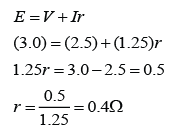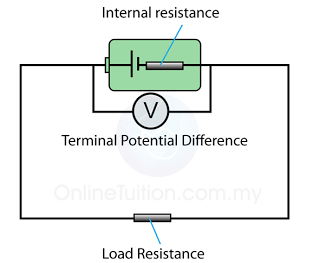
Load Resistance
The load resistance in a circuit is the effective resistance against the moving charge outside the source of electric.Terminal Potential Difference
Terminal potential difference or terminal voltage is the potential difference across the two terminal (the positive terminal and the negative terminal) of an electric source (cell or generator).Internal Resistance and Potential Difference Drop
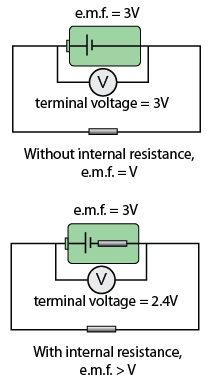
- If the internal resistance is ignored, the terminal potential difference is equal to the e.m.f.
- If the internal resistance is present, the terminal potential difference will be lower than the e.m.f.
- The relationship between e.m.f. and the terminal potential difference is given by the following equation.
Equation
E = V + IrorE = IR + Ir
E = e.m.f.
V = terminal potential difference
I = current flows in the circuit
r = internal resistance
R = the load resistance
A cell has internal resistance 0.5Ω and the potential difference across the cell is 4V when a 2A current flows through it. Find the e.m.f. of the cell.
Answer:
r = 0.5Ω
V = 4V
I = 2A
E = ?
E = V + Ir
E = (4) + (2)(0.5)
E = 5V

A cell with e.m.f. 3V and internal resistance, 1Ω is connected to a 5Ω resistor, and a voltmeter is connected across the resistor as shown in the diagram on the left. Find the reading of the voltmeter.
Answer:
E = 3V
r = 1Ω
R = 5Ω
V = ?
E = I(R + r)
(3) = I(5 + 1)
3 = 6I
I = 3/6 = 0.5A
V = IR
V = (0.5)(5)
V = 2.5V
Measuring e.m.f. and Internal Resistance
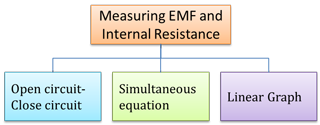
Three methods can be used to measure the e.m.f. and internal resistance.
- Open circuit-Close circuit
- Simultaneous equation
- Linear Graph
| Open Circuit |
 |
| In open circuit ( when the switch is off), the voltmeter shows the reading of the e.m.f. |
| Close Circuit |
 |
| In close circuit ( when the switch is on), the voltmeter shows the reading of the potential difference across the cell. |
With the presence of internal resistance, the potential difference across the cell is always less than the e.m.f..
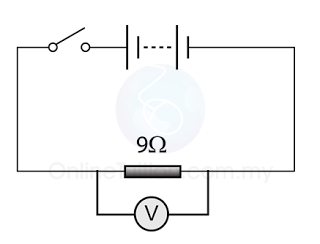
The diagram above shows a simple circuit that connect some baterries to a resistor. The voltmeter shows a reading of 5.0V when the switch is off and 4.5V when the switch is on. What are the e.m.f. and the internal resistance of the cell?
Answer:
When the switch is off, the reading of the voltmeter shows the e.m.f. of the batteries. Therefore.
e.m.f. = 5.0V
When the switch in turned on, the reading of the voltmeter shows the potential difference of the resistor. Therefore,
V = 4.5V
The current that pass through the resistor,
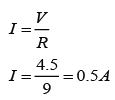
E = V + Ir
(5.0) = (4.5) + I(0.5)
0.5I = 5.0 - 4.5
I = 0.5/0.5
I = 1A
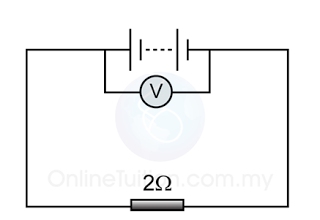 |
| Diagram (a) |
 |
| Diagram (b) |
A cell is connected to a circuit as shown in diagram (a). The graph in diagram (b) shows the change of the reading of the voltmeter, V against time, t. If t is the time where the switch is close, find
(a) the e.m.f. of the cell
(b) the internal resistance of the cell.
Answer:
(a) Before the switch turned on, the reading of the ammeter shows the e.m.f. of the cells.
From the graph, the e.m.f. = 3.0V
(b)
e.m.f., E = 3.0V
Potential difference across the resistor, V = 2.5V
Current that pass through the resistor,

